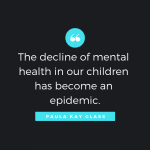“Billy, that is the umpteenth time you’ve gone to the pencil sharpener. You need to sit down and get to work!” The teacher is frustrated with Billy as he continues to get out of his seat to walk around the room to the pencil sharpener. And then she reflects on what she recently learned about distractions and lack of focus in students in her classroom.
She walks over to Billy and quietly asks him if he needs to go to the water fountain to reset or if he needs to go to the “Peace Corner” in Miss Smith’s classroom. He nods and leaves the room to return in about 15 minutes. He seems to be calmer, and he sits and works on his assignment the rest of the class time. As he leaves the room at the end of class, the teacher lightly pats him on the back to show her care and concern. No words are needed but he gets the message, “This teacher cares about me.”
As a certified Trauma-Informed Care Trainer and Mentor/Title I Interventionist in a Trauma-Informed Care middle school within the Tennessee Cohort of Trauma-Informed Schools, I know many stories that can attest to the improvement in classroom management once the facts and science behind Trauma-Informed Care are shared with teachers around our county, our state, our country, and even other countries.
The Research Says…
There is significant research that has proven that during early childhood, when children experience traumatic situations on a continual basis, whether it is parental neglect, abuse, witnessing violence, constantly moving, poverty, etc, the brain literally develops differently than a child who has been nurtured and cared for, raised in a calm and organized home with parents who interact with them and meet their needs.
We as educators cannot always change their living arrangements, but we can be a change agent for helping to develop their brain to a “ready to learn” brain. There are many strategies to rebuild the child’s brain, and we can make a difference in that child’s future by putting these strategies to work. But the first step to making a difference is to be that caring adult for a child.
In a trauma-sensitive classroom, the teacher does not assume that every child placed in his/her care day-to-day has the brain development they need to process what is expected of them; how to organize their materials and assignments for completion, how to follow through on multiple-step instructions, or how to interact appropriately in a group activity We are not saying that students are incapable of doing those things but that some need guidance and rewiring of the brain to eventually accomplish these functions on their own.
The Amygdala vs The Prefrontal Cortex
The research tells us that each time a child has a stressful experience – if it is not handled with care – the brain loses a connection that would have been a part of the “ready to learn” part of the brain, the prefrontal cortex. Instead, the amygdala, the alarm system, gets activated. If the amygdala is activated constantly over time due to chronic stress, the amygdala becomes overdeveloped and the prefrontal cortex becomes underdeveloped. The brain is designed that the amygdala is only supposed to activate when a person is in danger such as a house fire, stepping in front of a car, etc. “Fight,” “flight,” or “freeze” are the three possible reactions that the amygdala commands our brain to do when in danger.
If the amygdala is overdeveloped from constant triggering, then it stays fired on a constant basis. When children have chronic stressful situations, the amygdala gives these students a sense of heightened awareness and a super-vigilant mental state always looking for the next thing to happen.
The prefrontal cortex is developed as well by repetitive actions, such as when something upsetting happens to a child and he/she is comforted, that connection in the brain is made. When a child is nurtured and cared for on a regular basis and trauma happens, the prefrontal cortex is being developed when the appropriate response is given to the child. The prefrontal cortex houses the part of the brain where attention span, logical reasoning, and problem-solving dwell. In this case, the brain is being developed into a “ready to learn” brain.
So this is like working out in the gym. If we do exercises to strengthen our arm muscles but we do not work our leg muscles, we will have strong arms, but we will have weak legs. It is the same with the amygdala versus the prefrontal cortex. The amygdala unfortunately gets more exercise than the prefrontal cortex in the brain of a child who suffers from toxic stress, adverse experiences that are strong, frequent, and/or prolonged.
Therefore, these students walk into your school building already in a high-stress mindset, and they react to the next trigger in many different ways. When the amygdala alarm goes off, people react by “fight,” “flight,” or “freeze.” These could be seen as withdrawal and reservedness or argumentative and defiant. With training in Trauma-Informed Care approaches, the teacher will be aware of these adaptations, and it will help the classroom teacher recognize when a student is reacting to stress.
Trauma Informed Care
Trauma-Informed Care is a mindset, a shared understanding, a common language that enables us as educators to empathize with students to help equip them with the skills necessary to be life-long learners. Trauma-Informed Care is not a program that a teacher must add to an already loaded plate, but an understanding that will empower the teacher to recognize and respond appropriately when adaptations arise in the classroom. This will not only assist the teacher in dealing with issues and disruptions but it will create a safe and healthy environment for all learners in the classroom.
In the second part of this article, I will discuss strategies to create a Trauma-Sensitive Classroom that, with a lot of understanding and a little effort on your part, you will see your classroom become more productive and maybe even more peaceful.
Below are some links to some information resources for you to acquaint yourself with Trauma-Informed Care practices and Trauma-Sensitive Schools.
https://www.edweek.org/teaching-learning/some-faqs-for-educators-on-childrens-trauma/2019/08






